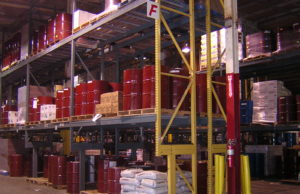Storage and Handling Basics – Containers
01 Aug 2020, Posted by in Oil TipsLubricating oils and greases require proper storage and handling to avoid deterioration, contamination, and even costly waste disposal. From damaged containers to excessive heat or cold exposure, many factors that can cause deterioration and waste can easily be avoided by following a few best practices. See how you can improve your storage and handling procedures to reduce waste and ensure the integrity of stored lubricants.
Containers
 Drums, pails, and cans of lubricants from virtually all suppliers are leak-proof and clearly labeled with a brand name and type of lubricant inside. Careless handling, however, can cause leaks, contamination of the contents, and smudge, tear, or otherwise damage the labels.
Drums, pails, and cans of lubricants from virtually all suppliers are leak-proof and clearly labeled with a brand name and type of lubricant inside. Careless handling, however, can cause leaks, contamination of the contents, and smudge, tear, or otherwise damage the labels.
The 55-gallon drum is the most common lubricant container used by industry. Care is the key to safe drum handling. A full drum weighs about 450 lbs and, if handled carelessly, can injure workers or damage plant property. Do not unload drums by dropping them from the delivery truck or freight car to the ground or unloading dock. The drum’s seams can be punctured or burst, resulting in a hazardous spill situation.
Correct unloading procedures will prevent damage to drums and injury to personnel. Delivery trucks generally have hydraulic lift gates to lower drums to the ground or unloading platform. Hand-winch hoists can do the same. Drums can also be unloaded from trucks or freight cars by sliding them down wood or metal skids. Before unloading with skids, set truck brakes and chock the wheels. Attach skid to the truck or freight-car bed securely. NEVER allow a drum to skid or roll under its own momentum — always keep direct control. Technical Topic Handling & Storing Lubricants
Once unloaded, the drums should be moved immediately to the storage area. The best way is by fork truck, with the drums secured on pallets or held by fork jaws. If using fork jaws, the jaws must have adapters that take the same shape or curvature of the standard 55-gallon drum. Standard straight jaws will require too much squeeze pressure to keep the drums elevated. If fork trucks are not available, barrel trucks or drum handlers can be used.
If the floor between the unloading and storage areas is flat and smooth, drums can be rolled into the storage area. The drum’s hoops (also called chimes) will protect it from damage, but care must be taken to avoid rolling the drum over sharp objects that could puncture shell. Also, DO NOT allow the drum to slam on the ground when repositioning it from its upright position to its side. Two people should handle any repositioning and rolling of a drum. Again, NEVER allow the drum to roll under its own momentum — maintain firm control of drum speed.
Five-gallon oil pails and 35-lb grease kegs are usually shipped on pallets. Smaller cans of lubricant usually come in fire-board cartons. All should be handled with the same care given drums. Cartons should be left sealed until they are in the storage area to reduce the risk of the carton falling apart during movement.
If you need help designing a storage and handling plan for your lubricants, please contact us. Our team of industry experts has over 30 years of experience in storage and handling practices. We are here to help you.
